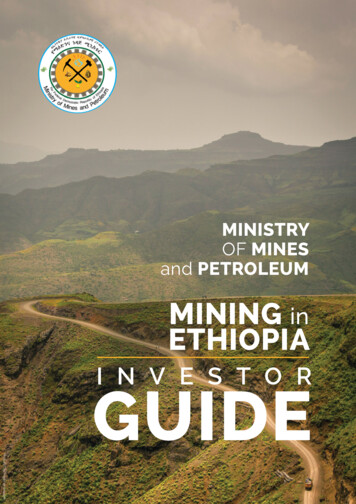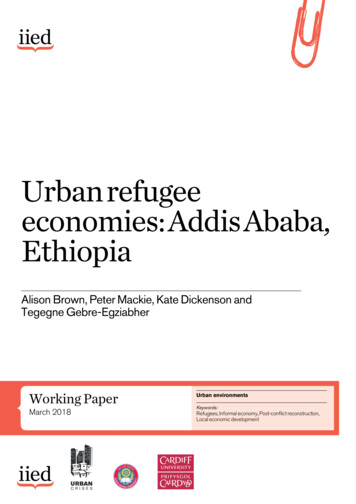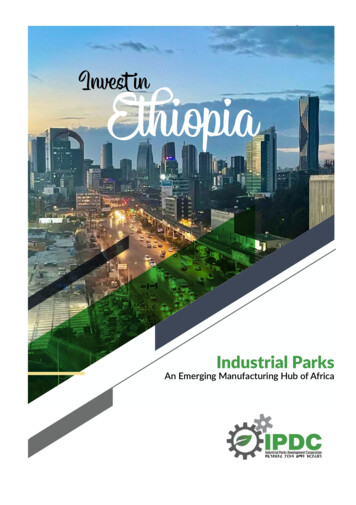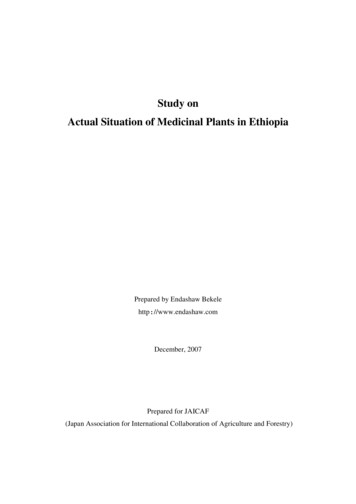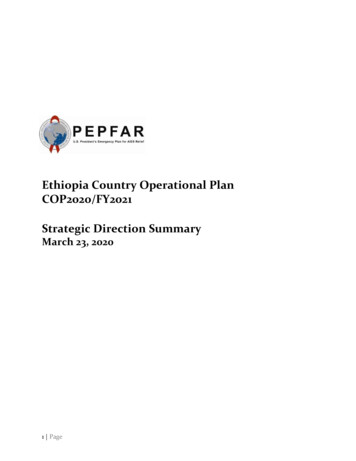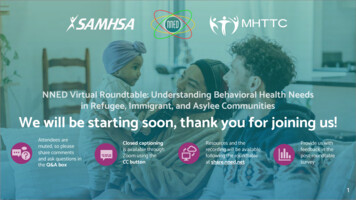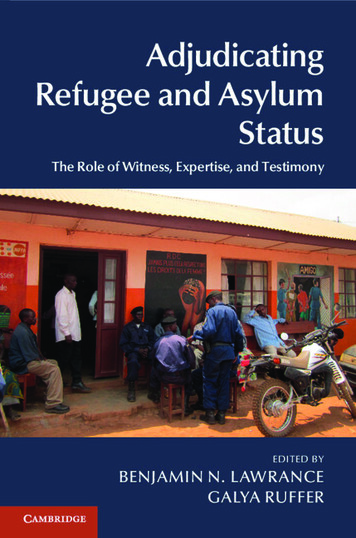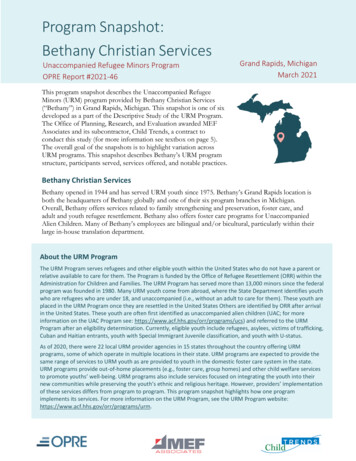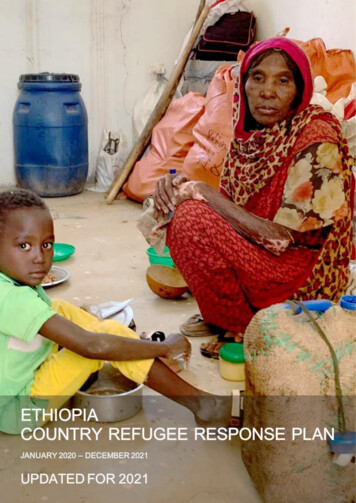
Transcription
ETHIOPIA COUNTRY REFUGEE RESPONSE PLAN1ETHIOPIA COUNTRY RRP UPDATED FOR 2021
ETHIOPIA COUNTRY REFUGEE RESPONSE PLANCREDITS:UNHCR wishes to acknowledge the contributions of humanitarian and development partners in Ethiopia, together with the UNHCRHeadquarters, Geneva and UNHCR Regional Bureau for the East and Horn of Africa in the preparation of this document.The maps in this publication do not imply the expression of any opinion on the part of UNHCR concerning the legal status of anycountry or territory or area, of its authorities, or the delimitation of frontiers or boundaries.All statistics are provisional and subject to change. Except where indicated otherwise, all population figures provided in this reportare as of December 31, 2020.PHOTO CONTENT:A family of Eritrean Kunama refugees have found emergency -temporary shelter in the Mai Aini Secondary School. A convoy arrivedfrom Shire on 11 February 2021 transporting over 600 refugees. Families had fled violence in Shimelba refugee camp, first toShiraro where they ran out of food, and then to Shire in search of safety and assistance. UNHCR/Edward Leposky2ETHIOPIA COUNTRY RRP UPDATED FOR 2021
ETHIOPIA COUNTRY REFUGEE RESPONSE 454647546163646568727475768084858688Overview of Planned Response January–December 2021Country Overview - BackgroundInter-agency ResponseBeneficiary PopulationNeeds AnalysisResponse Strategy and PrioritiesResponse ObjectivesTigray RegionCross Cutting Operational PrioritiesPartnership and Coordination2021 Financial Requirements SummaryBy Sector and PPGBy PartnerEritrean RefugeesOverviewNeeds AnalysisResponse Strategy and Priorities2021 Financial Requirements by Partner and SectorSomalian RefugeesOverviewNeeds AnalysisResponse Strategy and Priorities2021 Financial Requirements by Partner and SectorSouth Sudanese RefugeesOverviewNeeds AnalysisResponse Strategy and Priorities2021 Financial Requirements by Partner and SectorSudanese RefugeesOverviewNeeds AnalysisResponse Strategy and Priorities2021 Financial Requirements by Partner and SectorUrban, Kenya Borena and Other RefugeesOverviewNeeds AnalysisResponse Strategy and Priorities2021 Financial Requirements by Partner and SectorANNEX2021 Financial Requirements by Partner and SectorMonitoring Framework3ETHIOPIA COUNTRY RRP UPDATED FOR 2021
ETHIOPIA COUNTRY REFUGEE RESPONSE PLANCONTEXT4ETHIOPIA COUNTRY RRP UPDATED FOR 2021
ETHIOPIA COUNTRY REFUGEE RESPONSE PLAN2021 PLANNED RESPONSE884,216US 552.6 M29PROJECTED REFUGEE POPULATONINTER-AGENCY SISTED HOST COMMUNITYThe boundaries and names shown, and the designations used on this map do not imply official endorsement or acceptance by the UnitedNations. Arrows shown on this map are only indicative of displacement movements, and the refugee locations used only indicative of therefugee-hosting areas.Refugee Population TrendsRequirements by Refugee PopulationIn millions 735,204802,821884,216Eritrean Refugees84Somalian Refugees132South Sudanese Refugees5Total 2019 PopulationTotal 2020 Population2021 Projected Population247Sudanese Refugees44Urban, Kenya Borana & OtherRefugees45ETHIOPIA COUNTRY RRP UPDATED FOR 2021
ETHIOPIA COUNTRY REFUGEE RESPONSE PLANCountry OverviewBackgroundEthiopia has a long-standing history of hosting refugees and is currently the third-largest refugee operation in Africa andone of the largest refugee asylum countries worldwide, reflecting the ongoing fragility and conflict in the East and Hornof Africa region. The country has provided protection to ref ugees and asylum seekers from some 26 countries. Amongthe principal f actors are predominantly the conf lict and f ood insecurity in South Sudan, the prevailing politicalenvironment in Eritrea together with the conflict and drought in Somalia.The Government of Ethiopia continues to strive to implement its commitments made at the 2019 Global Ref ugee Forum,as well as the nine Pledges made during the Leader’s Summit in 2016 to support the gradual inclusion of refugees innational services. Through the Pledges, which serve as a vehicle f or implementing the Comprehensive RefugeeResponse Framework (CRRF) in the country, Ethiopia seeks to expand its Out-of-Camp policy (OCP); provide workpermits to ref ugees; increase enrolment in primary, secondary and tertiary education; provide access to irrigable landf or crop cultivation; f acilitate local integration in instances of protracted displacement; earmark a percentage of jobswithin industrial parks to refugees; and provide access to vital events documentation to f acilitate increased access tobasic and essential social services.In this connection, Ethiopia’s parliament adopted revisions to its existing national ref ugee law on 17 January 2019,making it one of the most progressive refugee policies in Af rica. The Law provides ref ugees with the right to work andreside out of camps, access social and f inancial services, and register lif e events, including births and marriages.Fulf illing these considerable and measurable Government commitments to f urther its duty of care to ref ugees relativeto its existing national resource constraints will inevitably be based on the scale-up of equitable responsibility-sharingbetween UN Member States and other key stakeholders.The national asylum procedures are established by the Law, and the Government of Ethiopia has thus far maintainedtheir traditional policy of granting prima facie refugee status (group-based recognition) to South Sudanese, Sudaneseoriginating from the Blue Nile and South Kordofan region, Yemenis arriving in Ethiopia after 1 January 2015, and Somalisoriginating from South and Central Somalia, while nationals from othercountries undergo individual ref ugee status determination. However,in January 2020, the Government of Ethiopia announced a change in2020 New Arrivals 26,417policy away f rom granting prima facie ref ugee status f or Eritreannationals towards a hybrid asylum system whose content is yet to beAge% ofFemaleMalecommunicated to UNHCR. Some 3.8 percent of the ref ugee populationgrouptotal% of% ofin Ethiopia lives in a protracted situation f or over 20 years, including26ktotaltotalmostly South Sudanese and Somali refugees.26k26kThe ref ugee f low to Ethiopia continued during 2020 with 26,41700-04 y.19%9%9%persons seeking safety and protection within the country’s borders. At05-11 y.21%11%11%the start of 2021, Ethiopia hosted 802,821 refugees, who were forcedto f lee their countries of origin as a result of insecurity, political12-17 y.13%6%7%instability, military conscription, conflict, conflict-induced f amine, andother challenges. The majority of ref ugees in Ethiopia are located in18-59 y.45%26%19%the Tigray region (although some have been forcibly displaced outside60 y.2%1%1%of the region due to the ongoing conflict as described below) and thef our emerging regions of Ethiopia: Af ar; Benishangul-Gumuz;Total100%53%47%Gambella and Somali regions. The emerging regions are the leastdeveloped regions in the country characterized by harsh weatherconditions, poor inf rastructure, low administrative capacity, a high level2020 End-Of-Year Population 802,821of poverty and poor development indicators. The arid physicalenvironment in the Af ar and Somali regions and the small andAge% ofFemaleMalescattered nomadic populations make it more challenging to providegrouptotal% of% ofservices to refugee and host communities alike. Many parts of the four802ktotaltotalregions are inaccessible with limited, poor or no road infrastructure. A802k802kmajority of Eritrean ref ugees granted the OCP status reside in Addis00-04 y.16%8%8%Ababa and are largely dependent on f inancial remittances fromabroad, as they are not entitled to humanitarian assistance outside of05-11 y.26%13%13%the camps and alsof ind it dif f
Ethiopia has not formally resumed admission of new arrivals, while applying exceptions depending on humanitarian situations. The registration of new arrivals is currently suspended. As at 3 January 2021, a total of 125,622 cases had been confirmed in the country and 1,948 deaths reported1. The first case among refugees was reported on 5 June 2020
